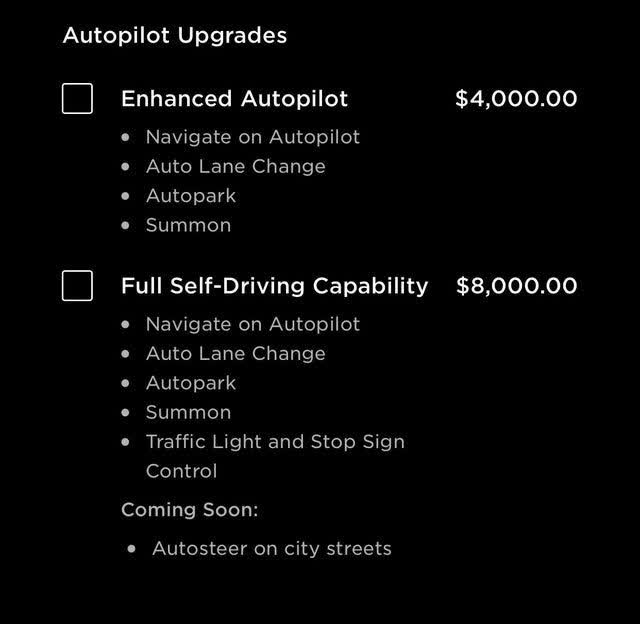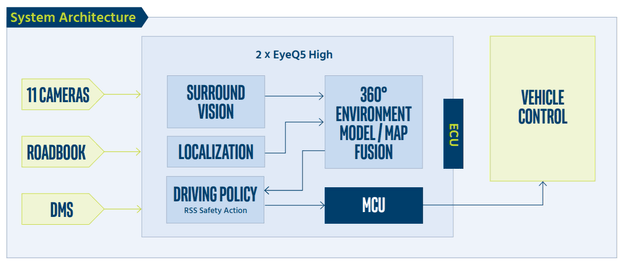In September, Intel (INTC) announced a landmark milestone for the automotive industry that might have been underappreciated. In particular, Intel announced the industry's first L4 system for consumer AVs (autonomous vehicles, Level 4 means almost fully autonomous), called SuperVision. So, not just for robotaxis, but for consumers. It is likely several steps above the latest Tesla (TSLA) Autopilot, as it is derived directly from Mobileye's L4 self-driving fleet (operating since at least 2018 in Jerusalem). Launch is slated for Q3'21. I reckon this could mark the start of the autonomous vehicle revolution over the coming decade.
Together with another announcement for its robotaxi business, Mobileye is proving almost by the month that it is the real #1 in autonomous vehicles. On the robotaxi side, Mobileye is expanding its operations to Dubai, with commercial operations to start in 2023.
What this means is that Intel's Mobileye keeps executing pretty much flawlessly, as evidenced by this being no less than my fourth article on Mobileye this year. I have heard several times that some investors hang onto Intel just because of Mobileye. With the progress Mobileye has made yet again in 2020, this likely continues to be justified.
Investment Thesis
As a comment under an earlier article explained:
So while everyone is throwing a fit about 10nm versus 7nm, Mobileye and AV could actually be the real future of $INTC. If true, and the article makes a very plausible case for it, then, as @aphmd notes, this could very well be reminiscent of $MSFT. I actually bought $MSFT in 2012, when everyone was shunning Balmer and causing the stock to linger under $30, and now I think I'm more comfortable holding onto $INTC, which I have owned since 1995, collecting the dividends and seeing how all this plays out.
Robotaxi expansion continues: Dubai next
In July, I published a quite lengthy article covering both the robotaxi and ADAS parts of Mobileye in function of its latest design wins, so I will keep this update brief. At the time, I covered Mobileye expanding its robotaxi partnerships, which already included Israel, France and South Korea, to also include Japan and Southeast Asia.
The latest partnership further adds Dubai aka UAE to the list. Testing will start in late 2021, and commercial operations in 2023. The agreement also includes solutions for smart cities.
Overall, this latest announcement gives the impression that Mobileye is not stopping with looking for partnerships, and continues what seems a steady pace of obtaining such new collaborations.
World’s most advanced ADAS: SuperVision
On the ADAS side, Mobileye announced its most advanced ADAS (advanced driver assistance system) solution yet, incorporating all the latest technology that Mobileye has developed. Mobileye recognizes it as the world's most advanced ADAS. This is because it is directly derived from its AV system development: its EyeQ5 SoC (system-on-a-chip), its RSS driving policy for advanced autonomous assistance features and self-driving capabilities (RSS is mathematical model of safety), its REM crowdsourced mapping (REM is a crowdsourced, high-accuracy map created by using the cameras on millions of existing Mobileye-powered vehicles), as well as almost a dozen cameras.
This is the landmark system I referred to in the introduction. I believe Mobileye is not really doing it enough justice, as Mobileye calls it L2++ officially. However, in an investor discussion, Mobileye's CEO has confirmed that SuperVision is basically taking the full camera-only subsystem of Mobileye's self-driving fleet and putting it as an ADAS solution in a consumer vehicle. (Hence, I coined it semi-L4 in the title.)
ADAS or L4?
So, what then is the difference between this "L2++" SuperVision and a real L4 system, if the hardware and software are identical? The distinction is in what is expected from consumers (and vice versa). In L4, consumers can basically take the backseat, with no intervention ever assumed. SuperVision, on the other hand, is not verified for L4, since it has a lower mean time between failure (MTBF) than is expected from an L4 system.
This is because, as mentioned, it only uses cameras, and it lacks the radar and/or lidar sub-system. Mobileye's approach to L4 is to develop two fully separate sub-system: one based on cameras, and one on other sensors such as lidar/radar. Since those sub-systems do not do things like sensor fusion, they are fully independent. (For those who know a bit of probability, that means the probability of failure becomes the product of the two sub-system failing simultaneously.) That is how Mobileye intends to get to the required reliability for L4.
Altogether, while Mobileye categorizes it as L2++, surprisingly, under the hood (so to speak) are real L4 capabilities.
Mobileye and lidar start-up Luminar recently announced a partnership. Mobileye also said previously it is developing imaging radar in-house, which it plans for 2023.
Commercialization
Mobileye is commercializing SuperVision through a new ADAS design win and broader partnership with Geely Auto Group (GELYF), pertaining mostly to China. In particular, SuperVision will feature in Lynk & Co. brand’s upcoming premium Zero Concept EV, launching in Fall 2021 (Q3'21).
Mobileye noted that it is responsible for the full integration of the end-to-end system, acting more like a Tier 1 rather than a Tier 2 as it has traditionally been: "This win marks the first time Mobileye will be responsible for the full solution stack, including hardware and software, driving policy and control." Mobileye also noted how unprecedentedly fast it is able to deliver this solution to market in just one year, one-third the usual time.
So, SuperVision is notable for several reasons. In my January article on Mobileye, I remarked that Mobileye was on track to continue its ADAS market share dominance into L2+. The company’s most advanced L2+ solutions are based on its EyeQ4 SoC, which was initially launched in 2018, and also features its crowdsourced, near-real time REM mapping. (Mobileye is the only player in the industry with this capability, which substantially improves geographic scaling.) The 7nm based EyeQ5, on the other hand, has been used for the company’s autonomous fleet since late 2019.
This system, which today we are launching as Mobileye SuperVision™, is a direct derivative of our autonomous driving program and utilizes the camera-only portion of our truly redundant sensing suite that we are developing for Level 4 autonomous vehicles (AVs).
This new design win likely will be one the first or second to bring the EyeQ5 to market. In 2018, news about the BMW iNEXT (BMWYY) came out, which, at the time, was noted for its multi-million unit deal size, although expectations that it might have been an L4 system have not come to fruition, as it now seems to be an L3 system (and renamed to iX(5)).
It will also mark the first time that it is bringing its RSS driving policy to market. RSS is used in SuperVision as an ADAS solution, which means it can do corrective manouvres to improve safety.
In particular, the features this enables are:
- Hands-free highway (including lane change, highway to highway, on/off ramps) and urban driving;
- Automated parking;
- Automatic micro-maneuvers (steering, braking) based on RSS (with the goal of avoiding unsafe situation);
- Legacy ADAS features;
- Over-the-air (OTA) updates.
Altogether, this will likely be the most advanced ADAS in the market, likely beating Tesla (Enhanced) Autopilot by a stretch. In its editorial, Mobileye’s CEO also remarked that Mobileye has always had OTA capabilities, likely in a nod to the relatively recent Nvidia (NVDA)-Mercedes Benz (DDAIF) collaboration for 2024.
While unconfirmed, given that NIO Ltd. (NIO) has prided itself a being a leading Mobileye partner and adopter, I would expect NIO to follow suit with a similar announcement sooner or later. While it is already known NIO will integrate Mobileye’s self-driving system in 2022, perhaps it will also launch a model with SuperVision. In any case, during its Q2 earnings call, NIO stated it was increasing its investments in autonomous driving.
Besides SuperVision in the Zero Concept, Geely also signed a long-term, high-volume ADAS agreement for its broader portfolio. After Ford (F) and a “major Asian OEM,” this marks the latest high-volume ADAS win this year for Mobileye: the group represents an annual overall volume of 1.5 million units.
Comparison to Tesla Autopilot
Tesla recently (re)introduced "Enhanced Autopilot" for $4,000, as a step below Full Self-Driving, which (currently) costs $8,000.

Based on the feature lists presented by both companies, Mobileye SuperVision indeed seems to have an edge. For example, Mobileye has been testing its self-driving fleet since at least 2018, while Tesla in 2020 has been working on its "software rewrite": "Tesla Battery Day: Full Self-Driving Next Month."
Progress
It might be useful to sum up the progress Mobileye has made in less than one year after its November 2019 Investor Summit.
First, progression up to and including its investor meeting:
- Crowdsourced REM (RoadBook) adopters include BMW, Volkswagen (VWAGY), Nissan (NSANY) and NIO.
- Robotaxi announcements include China public transportation, Israel and France, and U.S. independently.
Further progress in 2020:
- Bringing RoadBook (REM) to China via SAIC.
- Expanding MaaS to South Korea (Daegu City), Japan, Taiwan and Southeast Asia (Willer) and Dubai/UAE (Al Habtoor Group).
- Moovit acquisition (May), including announcement of RaaS and VaaS business models, and confirmed integration (September) of Moovit's system with Mobileye's self-driving fleet.
- Germany AV testing permit, marking international expansion. Also on track to start testing in Detroit.
- Ford ADAS partnership: multi-million annual units, showing Mobileye logo and proof point of customizing Mobileye's software, and potentially adopting RoadBook.
- Geely Auto Group ADAS partnership: SuperVision brings RSS, EyeQ5 and OTA to ADAS, and marking a proof point towards its commercial self-driving system, as first time acting as Tier 1 (responsible for full solution stack).
- Confirming (no delays to) 2022 robotaxi schedule.
Takeaway
On the ADAS side, Mobileye continues to lead the industry forward with the world’s most advanced ADAS solutions (design wins for 26 million units through Q3), now even directly derived from its AV program, which only increases its leadership position in that space. Mobileye already has a differentiated feature with its crowdsourced mapping, and SuperVision adds Mobileye’s RSS driving policy as well as bringing its 7nm EyeQ5 SoC to market. SuperVision blurs the line between self-driving and ADAS.
On the robotaxi side, Mobileye further increased its global footprint to Dubai. During a recent virtual conference, Mobileye also said that it had already connected its autonomous fleet to Moovit’s system, internally at least. Mobileye also said that it its 2022 robotaxi start remains on track, with no changes or delays.
While 2022 has never been the most ambitious timeline for entering robotaxis, I am not aware of any other company with such execution in either ADAS, self-driving or robotaxis, with little, if any, delays. SuperVision is coming to market in Q3'21, ahead of Mobileye's full L4 system in development with NIO for 2022.
Disclosure: I am/we are long NIO, INTC. I wrote this article myself, and it expresses my own opinions. I am not receiving compensation for it (other than from Seeking Alpha). I have no business relationship with any company whose stock is mentioned in this article.
The Link LonkNovember 23, 2020 at 06:18PM
https://ift.tt/33dngSB
Intel One-Ups Tesla Autopilot With (Semi-)L4 Launch - Seeking Alpha
https://ift.tt/2YXg8Ic
Intel


No comments:
Post a Comment